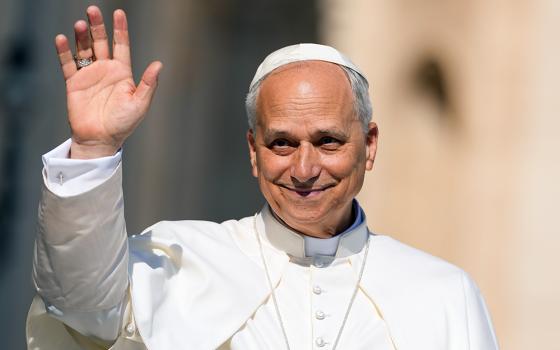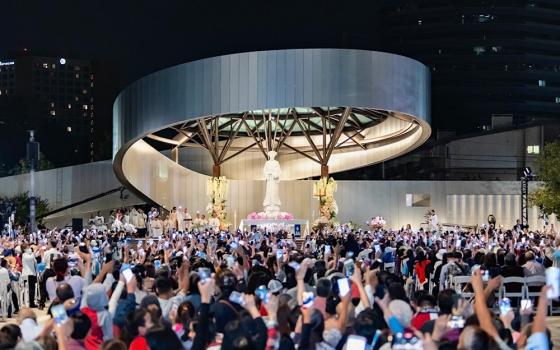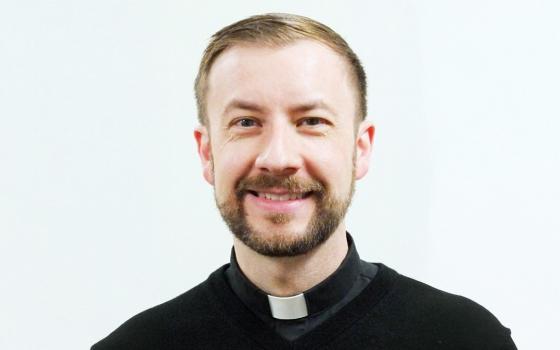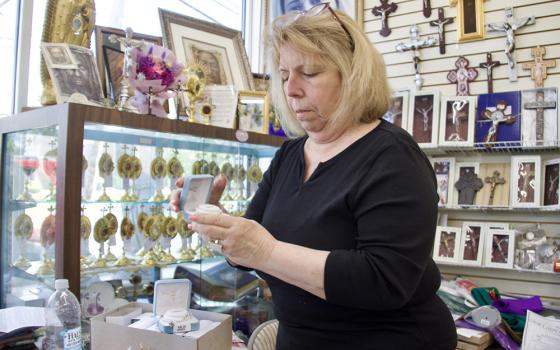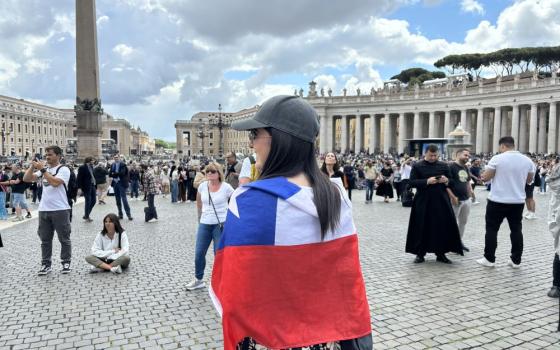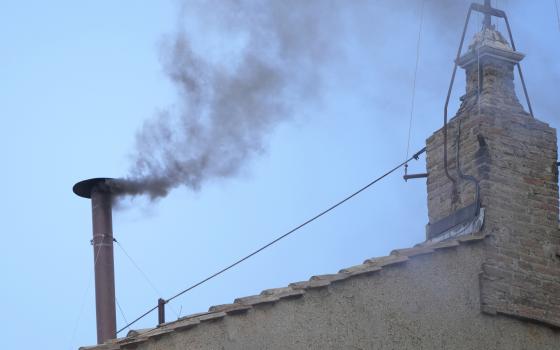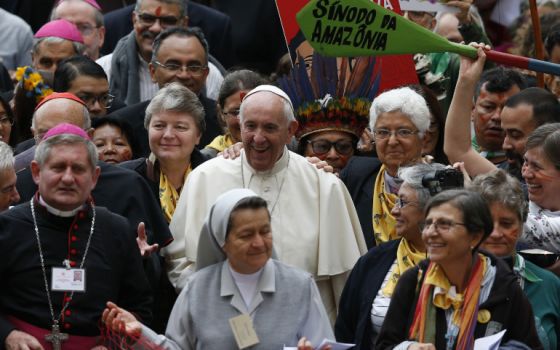
A prelate takes an oath of secrecy May 5, 2025, in preparation for the conclave at the Vatican to elect a new pope. The staff of the cardinals' residence hall, medical assistants and even the cardinals' bus driver took an oath swearing to protect the cardinals' privacy and the conclave's secrecy. (CNS/Vatican Media)
In a world of constant connection, where every moment is transmitted in real time, there is a place where time stands still and the most important decisions are made in silence, prayer and seclusion: the Vatican's Sistine Chapel.
On May 7, after the morning votive Mass at St. Peter's Basilica, where the cardinal electors pray for the Holy Spirit's guidance, the conclave for the election of the new pope will officially open.
The solemn liturgy, "Pro Eligendo Romano Pontifice" ("for the election of the Roman Pontiff"), will be celebrated by Cardinal Giovanni Battista Re, dean of the College of Cardinals. The cardinals who are over 80 years old and not able to vote will be able to attend the pre-conclave Mass.
That afternoon, the Catholic Church's most secret and fascinating ritual will begin.
The procession and entry into the Sistine Chapel
The cardinal electors will gather in the Vatican's Pauline Chapel and from there they will depart in procession, intoning the litany of the saints, to the Sistine Chapel. At the entrance, the "Veni, Creator Spiritus," the invocation to the Holy Spirit, will be sung.
Once inside, each cardinal will stand individually in front of a lectern with the Gospel open, where he will take a solemn oath of secrecy, resting his hand on the sacred text. Only at this point will Msgr. Diego Ravelli, master of papal liturgical celebrations, will say the Latin command, "Extra omnes!" which means, "Everyone out!" All but the 133 cardinal electors will have to leave the chapel.
The conclave will then officially begin.

The Sistine Chapel, arranged for the conclave to elect a new pope which begins May 7, is seen at the Vatican May 6, 2025. (CNS/Vatican Media)
Casa Santa Marta: where the cardinals will live
During the conclave, the cardinals will stay in Casa Santa Marta, the same residence chosen by Pope Francis. Rooms will be assigned by lottery, as confirmed by Matteo Bruni, director of the Holy See Press Office.
Each single and simple room will be equipped with a small private bathroom. Basic meals will be served in the refectory and prepared by selected staff, subjected to strict rules of silence and isolation. The planned menu includes:
- Breakfast: tea, coffee, bread and jam;
- Lunch and dinner: pasta or rice, white meat or fish, vegetables, bread and fruit;
- Drinks: small amounts of wine, absolutely no hard liquor;
- Desserts: only on rare occasions.
Kitchen staff will not be allowed to have any outside contact or talk to cardinals except for strictly functional needs.
Forbidden communications: electronic seclusion and anti-spy cleanups
To ensure maximum secrecy, all forms of communication will be prohibited and punishable by automatic excommunication "latae sententiae." Before entry, cardinals will have all electronic devices withdrawn and shielded: cellphones, tablets and computers.
In addition:
- The windows of the Sistine Chapel will be blacked out.
- Every room will be sealed and subjected to electronic sweeps against hidden bugs or transmitters.
- Even the rooms in Santa Marta, the common areas and even the kitchens will be monitored with anti-interception technologies.
- Travel between Santa Marta and the Sistine Chapel will take place on reserved, isolated and monitored buses along a route protected from any outside contact.
- Cardinals who wish to walk must mandatorily follow a protected route guarded by Vatican Swiss Guards.

As a restorer with the Vatican Museums touches up a wall fresco in the Sistine Chapel at the Vatican on May 2, 2025, workers prepare to build platforms over a protective covering on the marble floor. The cardinals who enter the conclave to elect a new pope May 7 will sit at tables facing the center of the chapel with the tables in the back row raised slightly. (CNS/Vatican Media)
The Sistine Chapel: pews, instruments and symbols
In the preceding days, arrangements have been completed in the Sistine Chapel:
- Desks have been set up for each cardinal, each equipped with:
- a pen;
- a folder with paper for notes;
- a booklet of the Liturgy of the Hours with Psalms;
- a copy of the "Ordo Rituum Conclavis," the liturgical guide to the conclave.
- Each seat will have a named placeholder. In the past, distinctive colors were used: red for cardinals created by the deceased pope, green for those who were created previously.
- To protect the mosaic floor, a raised platform was installed with wood panels, metal pipes, carpeting and ramp access.
Advertisement
The double stove and the smoke
In the corner of the Sistine Chapel, next to the chimney outlet, two stoves have been installed: a historic cast-iron one, used since the conclave of 1939 and engraved with all the dates of use and a modern one, introduced in 2005, which uses electronic chemical cartridges to avoid color ambiguity.
Each cartridge contains five charges that burn sequentially for about 7 minutes:
- Black smoke: potassium perchlorate, anthracene and sulfur.
- White smoke: potassium chlorate, lactose and rosin.
The chimney is preheated with electric heaters and has a fan to improve visibility. To confirm the white smoke, St. Peter's festive bells will also be activated, if they do not get jammed as they did last April 21.

White smoke billows from the chimney of the Sistine Chapel, announcing that a new pope had been elected, Wednesday, March 13, 2013. The new pope, Jorge Mario Bergoglio of Argentina, took the name Francis. (AP/Gregorio Borgia, File)
Voting: the ballot, the oath, the ballot box
The real election will begin from the afternoon of May 7, with the introduction of the ballot: a simple rectangle of paper where the cardinals will write, in mandatory non-recognizable handwriting, the name of the candidate.
There are three stages of voting:
1. "Antescrutinum" (before the voting):
- The ballots are distributed.
- A lottery designates three tellers, three auditors and three infirmarii (for sick cardinals).
- The ballot is marked "Eligo in Summum Pontificem" ("I Elect as Supreme Pontiff").
2. "Scrutinium vere et propieque" (the voting itself):
- Cardinals write one name, fold the ballot and hold it up.
- They advance to the ballot box, where they swear in Latin: "I call as my witness Christ the Lord, who will judge me, that my vote is given to the one whom, according to God, I believe should be elected."
- The ballot is laid on a silver platter and slid into the urn.
3. "Post-scrutinum" (after the voting):
- The ballots are counted. If the number does not match the number of cardinals, the ballots are burned and the voting is repeated.
- The first two tellers silently read the names, the third says them aloud.
- Ballots are punched, sewn with needle and thread, then burned in the stove.
- If there is no quorum, black smoke chemical mixture is added.

Cassocks for the new pope are arranged in the antechamber of the Sistine Chapel, sometimes called the "Room of Tears," on May 6, 2025, ahead of the conclave which begins May 7. (CNS/Vatican Media)
'Habemus papam': the revelation to the world
When a quorum is reached, the elected cardinal is asked two basic questions:
- "Do you accept the canonical election as Supreme Pontiff?" (In Latin: "Acceptasne electionem de te canonice factam in Summum Pontificem?")
- "By what name do you wish to be called?" (In Latin: "Quo nomine vis vocari?")
If he accepts, the new pope retires to the "Room of Tears" — inside the sacristy of the Sistine Chapel — where he wears the white papal robe for the first time.
The new pope will have three robes of three different sizes at his disposal. He will wear the one that fits him best, and in the first days of his pontificate a tailor will take his exact measurements to make him new clothes.
Shortly thereafter, the protodeacon of the College of Cardinals, Cardinal Dominique Mamberti will look out from the central loggia of St. Peter's and speak the words expected by the world:
"Annuntio vobis gaudium magnum: Habemus papam!" ("I announce you a great joy: We have a pope!")
"Eminentissimum ac everendissimum dominum" ("The most eminent and most reverend lord") and "dominum" is repeated for the second time, adding the first name of the elected cardinal.
Then the protodeacon completes the sentence, "Sanctae Romanae Ecclesiae Cardinalem" ("Cardinal of Holy Roman Church") at which point he adds the last name and then specifies the name by which the pontiff will be called …
"Qui sibi nomen imposuit ...": The world hears the name of the new pope for the first time ever.
The conclave closes. The crowd in St. Peter's Square likely erupts in a roar and the doors open again.
The new bishop of Rome appears and imparts the solemn "urbi et orbi" blessing ("to the city and the world").
The world has a new pope.

